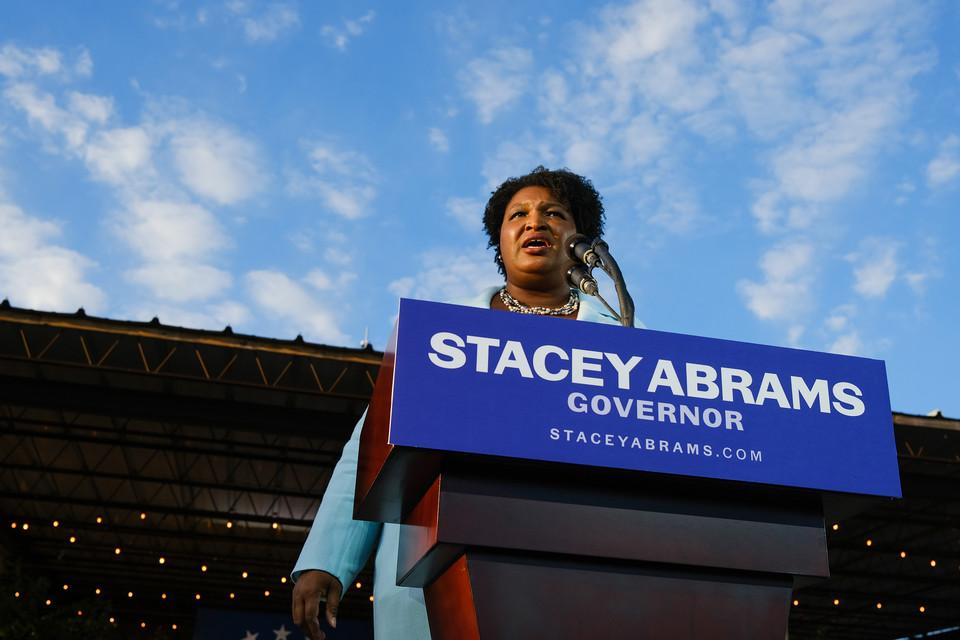
TLDR: Stacey Abrams, in her famous speech, asks three guiding questions: “What do I want?” “Why do I want it?” and “How am I going to get it done?” She urges individuals towards clarity in vision, motivation, and strategy. Through anecdotal evidence, repetition, and an appeal to ethos, Abrams effectively communicates a path toward achieving significant objectives.
So What? Abrams’ speech is a modern-day motivational classic, encouraging self-reflection and strategic planning. For aspiring communicators, this speech is a shining example of how a speech can move society forward.
Few political figures have had the impact that Stacey Abrams has had on modern politics. In part, this is due to her tireless efforts to mobilize voter turnout in her home state of Georgia–mobilization that some claim led to the state turning blue in the 2020 U.S. presidential election.
Another part of her success resides in her outgoing public persona, in which she presents a motivated, passionate figure seeking change. In her speech “Three Questions to Ask Yourself,” Abrams outlines a reflective framework that drives individuals toward a clear understanding of their goals, motivations, and strategies to achieve their objectives.
To do so, she leans heavily on the personal–namely, her personal experiences and successes.
Abrams and the Three Questions
At the heart of her speech, Abrams presents three questions that she asks herself when thinking about goals and objectives. After her unsuccessful bid for the Governorship of Georgia, she recalls confronting her commitment to seeing change in the world… which leads to her three questions:
“Unfortunately, you may have read the rest of the story. It didn’t quite work out that way. And now I’m tasked with figuring out how do I move forward?
… What do I do next? And I’m going to do what I’ve always done. I’m going to move forward because going backwards isn’t an option and standing still is not enough. You see, my race for governor by analyzing who I was and what I wanted to be. And there are three questions I ask myself about everything I do, whether it’s running for office or starting a business. When I decided to start the New Georgia Project to register people to vote or when I started the latest action, Fair Fight Georgia. No matter what I do, I ask myself three questions. What do I want? Why do I want it? And how do I get it?”
Through asking oneself, “What do I want?” “Why do I want it?” and “How will I get it done?” Abrams encourages individuals to harbor a well-defined vision, discern their driving forces, and craft a viable plan towards their objectives, thereby fostering a pathway towards significant personal and communal impact.
Use Personal Anecdotes

Let’s back up a few minutes into this speech. It takes Abrams nearly five minutes to get to the point of sharing her three questions. Before that, she tells the story of her political awakening:
“Well, one of the joys of being valedictorian in the state of Georgia is that you get invited to meet the governor of Georgia. I was mildly interested in meeting him. That was kind of cool.
… And when we get to the guard gate, the guard comes out and he looks at me and he looks at my parents and he says, “You don’t belong here. This is a private event.” My dad says, “No, this is my daughter, Stacey. She’s one of the valedictorians.”
But the guard doesn’t look at the checklist. That’s in his hands. He doesn’t ask my mom for the invitation at the bottom of her voluminous purse. Instead, he looks over our shoulder at the bus because in his mind the bus is telling him a story about who should be there. And the fact that we were too poor to have our own car, that was a story he told himself.”
Her experience as a poor black child in Georgia, being denied the same access as white children, shaped her drive for change. However, she notes that while these experiences drove her to seek change, it was still challenging to overcome the disappointment of defeat in the Governor’s race and look inward and guarantee that she had the passion to continue on this path.
At Media Shower, we’re big on using storytelling and personal experience to connect to audiences… it’s perhaps the strongest tool that communicators have. However, we want to show marketers that storytelling isn’t anything without authenticity. Abrams is open about her doubts and challenges and uses them as a catalyst for her teaching lessons.
Repetition, Repetition, Repetition
Repetition helps us learn. The repetition of specific words at the beginning of sentences is known as anaphora, and it takes this concept one step further by using language and proximity to drive a speech and create an emotional momentum (a famous version of this is Winston Churchill’s “We Shall Fight on the Beaches” speech).
Abrams uses this technique as well, albeit in a subtler form. The formulation of three questions relies on simple wording preceded by the same words and ideas:
- What do I want?
- Why do I want it?
- How do I get it?
She repeated these simple questions throughout the speech to frame important decisions, signaling a reflexive self-interrogation. The repetition of the simple what/why/how language uses repeated questioning to drive how we can use this in our lives. Additionally, the simplicity of the questions give them a certain power–these questions are simple to ask, but hard to answer.
The takeaway for marketers: keep it short, keep it simple, and keep it moving forward (see what we did there?). Repeating phrases to move an audience forward is an incredible way to get people to follow you to whatever message you are trying to convey.
Show the Proof in the Pudding
People love authenticity, and they love results. Abrams establishes her credibility (ethos) by sharing her accomplishments and the obstacles she overcame, which builds trust and serves as a testament to the effectiveness of the reflective framework she proposes.
“But in the pursuit, I became the first black woman to ever become the nominee for governor in the history of the United States of America for a major party. But more importantly, in this process, we turned out 1.2 million African American voters in Georgia, that is more voters than voted on the Democratic side of the ticket in 2014”.”
It seems pretty simple if we want to incorporate this into our communication: if you can show results, people will listen. More importantly, if you’re active in your profession, community, or area of interest, people will respect that knowledge and expertise.
Teach Through Experience
We often hear the criticism of marketing communications that sound too “sales-y.” The problem that people pick up with this kind of language is that it sounds insincere, untrustworthy, and uninspiring.
If we take the lessons from Stacey Abrams’ “Three Questions” speech, we can start to move away from the sales talk and legitimately connect with our audiences.
What do you want? Why do you want it? And how do you get it? Media Shower can help your marketing efforts with all three questions. Get a free trial and find out for yourself.
